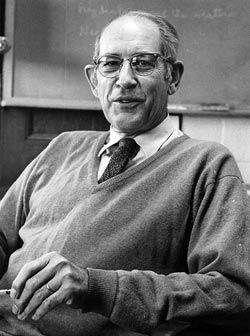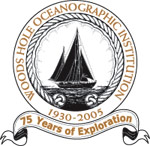This is an archived site. This site is no longer being maintained or reviewed for broken links.
Employee Portrait Gallery—K.O. Emery
 |
|
|
This tranquil office portrait of K.O. Emery belies a career that took him around the world for studies encompassing the broad Atlantic basin, submarine geology off southern California, Bikini Atoll, Hawaiian beach rocks, the East China Sea, and the Persian Gulf. He worked aboard many research vessels and dove in Alvin and DSRV Ben Franklin. He also ventured forth in a rowboat to do research for a book on Falmouth’s Oyster Pond, which bordered his back yard. It’s called A Coastal Pond Studied by Oceanographic Methods. (Photo by Bill Lambert) |
|
Kenneth O. Emery—better known as “K.O.”—was once described as “outspoken, plainspoken, and softspoken.” He developed strong character as a child of the Depression era, and he rode the rails and hitchhiked from his Texas home to Illinois and California, where he found jobs to earn money for tuition. Then he used the same means of transportation to get himself to college. He earned his academic degrees at the University of Illinois, where he was the protégé of Francis Shepard, generally considered the “father of marine geology.” K.O. worked for the University of California Division of War Research from 1943 to 1945, then taught geology at the University of Southern California for sixteen years before coming to WHOI in 1962. He helped recruit young geologists for what was then a geophysics department, and he also worked on western Atlantic continental margins with a group from the U.S. Geological Survey (USGS) that eventually became the USGS Woods Hole branch. He authored or coauthored 290 papers and 15 books, including Geology of the Atlantic Ocean with WHOI colleague Elazar Uchupi, The Destruction of Sodom, Gomorrah, and Jericho with his former student David Neev, and The Morphology of the Rocky Members of the Solar System with Uchupi. K.O. enjoyed exchanges with young scientists, and he served for a year as the first dean when the MIT/WHOI Joint Program was founded in 1968. He was the recipient of many scientific accolades, including election to the National Academy of Sciences, an honor afforded few oceanographers.
[back]

